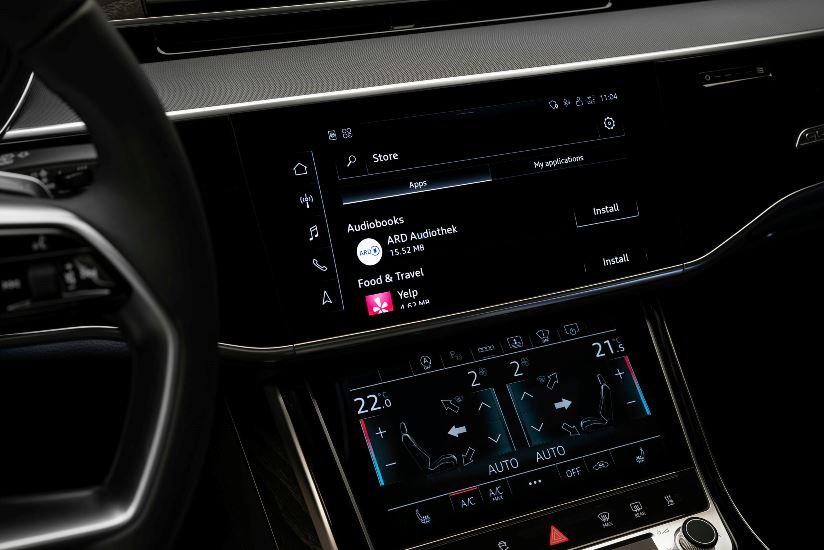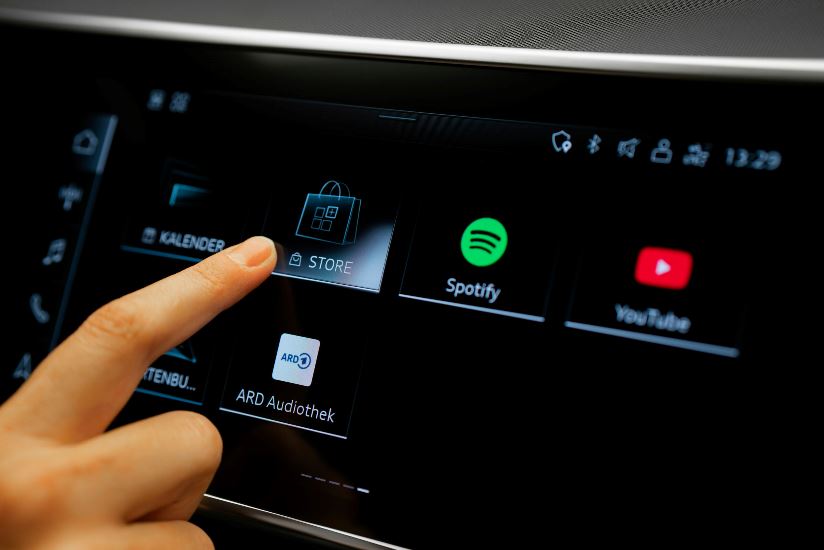 Direct access to popular third-party apps
Direct access to popular third-party apps
Regular software updates and a constantly growing range of apps for even stronger personalization of the infotainment system
Store with market-specific app portfolio expands third-generation modular infotainment toolkit
As of summer 2023, Audi is bringing a store for apps to selected models with the third-generation modular infotainment toolkit (MIB 3). With the embedding of the store, which was jointly developed with Volkswagen subsidiary CARIAD, customers can directly and intuitively access popular third-party apps through the Multimedia Interface (MMI) by means of a data link in the vehicle.
The apps selected by the customer can be installed in the MMI system seamlessly – without the need for a detour via a smartphone.
In its pursuit of ever-greater vehicle digitalization, Audi is integrating a native store for apps into selected models. The technical basis for the innovation is an expansion of MIB 3 with an additional electronic component: an Audi hardware module the size of a USB flash drive is loaded with an open-source operating and thus allows access to the third-party apps in the vehicle.
“Audi is the first brand within the Volkswagen Group to introduce a new store for third-party applications. Developed by CARIAD, this scalable solution is a proof point for our strategy to offer a highly attractive ecosystem for our customers.
With this solution, Audi drivers will not only enjoy regular software updates but also an even more personalized infotainment system,” said Oliver Hoffmann, CTO of Audi.
Innovative digital ecosystem
With the new store, customers gain access to a wide variety of apps, which can be downloaded directly and independently from the smartphone to the MMI. At launch, apps from the following categories are available: Music, Video, Gaming, Navigation, Parking & Charging, Productivity, Weather, and News.
The Music section, for example, includes apps such as Amazon Music and Spotify. The store will constantly grow with new apps being added all the time. Customers can access it via a separate MMI tile.
Afterward, the additional apps are seamlessly implemented in the MMI and can be used safely and reliably even while driving. The app portfolio is adapted specifically to the various markets.
Amazon’s voice assistant Alexa has been available in Audi models since 2019. From this summer, customers will always have access to the newest Version of the Alexa app as well as to additional features, such as an improved graphical interface and a new visual control panel to manage smart home devices.
Convenient billing
A data link is required to use the third-party apps, which is established via the so-called “embedded SIM”, a sim card permanently installed in the vehicle. For Audi owners in Europe, the costs that accrue from using the cellular network are billed conveniently via data volume with Cubic Telecom.
The first 25 gigabytes are free of charge. Naturally, Audi models will continue to support Android Auto and Apple CarPlay with the option “smartphone interface”.
In various Audi models as of summer 2023
The store for apps will be available from June in selected models that are equipped with the latest MIB 3 software cluster, specifically the Audi A3, A4/A5, Q5, A6/A7, A8, Q8 e-tron, and Audi e-tron GT.
These Audi models will be fitted with the store from the factory throughout the European market as well as Canada and the United States. The functionality will be expanded to additional models in 2023. The third-party apps are not available on vehicles with an earlier date of production.
Audi and CARIAD – a shared path
To develop and ensure the success of complex digital systems such as the new store for apps, Audi uses the bundled knowledge and synergies within the Volkswagen Group.
CARIAD, the group’s software company, is developing the technology stack for automated and connected driving – including of a consistent electronic architecture, a software platform, and a reliable connection to the automotive cloud – for all of the group’s brands.
CARIAD is also working on driver assistance systems, a standardized infotainment platform, and a new digital ecosystem centered around the car.






























